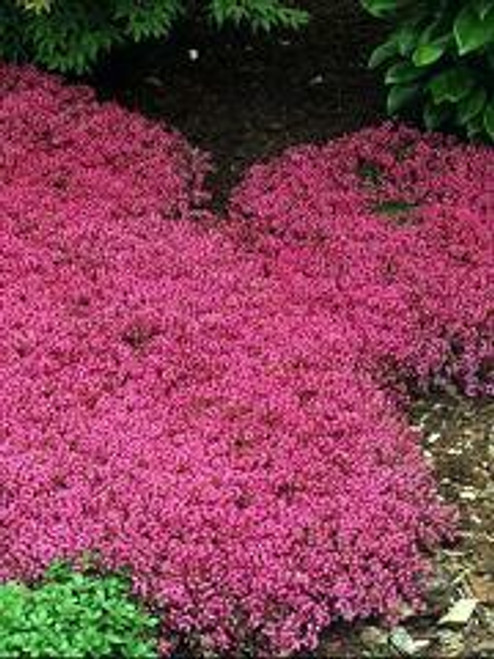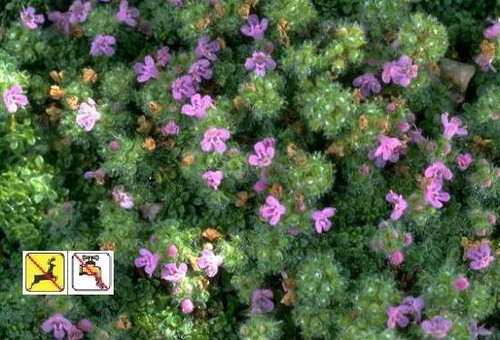Product Description
Thymus praecox 'Coccineus'
Common Name: Red Creeping Thyme
Zones 3 to 8.
Full sun.
Plants reach 1 to 4 inches tall and 12 to 18 inches wide;
fragrant evergreen groundcover.
Growth rate: Moderate.
Enliven your garden with the vibrant blooms and aromatic foliage of Thymus praecox 'Coccineus'! This charming groundcover, also known as Red Creeping Thyme, is a delightful addition to sunny landscapes, offering a profusion of rosy-red flowers and a fragrant, evergreen carpet.
- A Carpet of Color: 'Coccineus' transforms gardens into a sea of vibrant color with its abundance of small, rosy-red flowers. These cheerful blooms, appearing in dense clusters in late spring to early summer, blanket the plant in a vibrant display that attracts pollinators and adds a touch of whimsy to pathways, rock gardens, and borders.
- Fragrant Foliage: The tiny, dark green leaves of 'Coccineus' release a delightful, aromatic fragrance when brushed or crushed, adding a sensory dimension to your garden. This evergreen foliage forms a dense, mat-forming groundcover that provides year-round beauty and texture.
- Versatile and Hardy: This thyme is known for its hardiness and adaptability, tolerating drought, heat, and even light foot traffic. It is a perfect choice for challenging growing conditions, including xeriscaping, rock gardens, between stepping stones, or as a fragrant lawn alternative.
- Versatile Applications: This adaptable groundcover is a versatile addition to any sunny garden. Use it to soften pathways, edge borders, add a touch of color to rock gardens, spill over walls, or even create a fragrant tapestry between paving stones.
- Low-Maintenance Beauty: Thymus praecox 'Coccineus' is a low-maintenance gem that requires minimal care once established. Simply provide well-drained soil and occasional watering during prolonged dry periods.
Key Features:
- Rosy-Red Flowers: Abundant blooms create a vibrant display.
- Fragrant Foliage: Provides year-round beauty, texture, and aroma.
- Drought-Tolerant: Thrives in hot, dry conditions.
- Tolerates Foot Traffic: Perfect for pathways and between steppingstones.
- Versatile Applications: Suitable for borders, rock gardens, pathways, and more.
- Low-Maintenance: Easy to grow and care for.
Plant Specifications:
- Hardiness Zones: 4-9
- Mature Size: 2-4 inches tall, spreading to 12-18 inches wide
- Sunlight: Full sun
- Soil: Well-drained soil
- Water: Low water needs
Add a touch of vibrant color and fragrance to your garden with the delightful blooms and aromatic foliage of Thymus praecox 'Coccineus'!
Tolerating moderate traffic, Thymus praecox 'Coccineus' is an excellent choice for between stones on a path or cascading over walls; also as a border plant, in containers, for edging, ground cover, lawn substitute, mass plantings, and rock gardens.
Ten (10) plants in 4.5" containers per flat (or tray).
Other Details
The most important part of the plant is its root system. Healthy roots are the foundation of a healthy, vibrant plant. The type of plug container used is based on the specific needs of the plants. Perennials offered as bare root traditionally perform better when planted as bare root.Planted in a specialized mix, potted plants have well established root systems. Top growth stage will vary depending on the current life cycle and time of year when shipped. In Winter and early Spring dormant plants may be shipped. Dormant plants may be planted right away, even before the last frost date.
Most bare root varieties are field grown for at least one season, though Hemerocallis and Hosta are grown for two seasons. The bulk of the soil is removed during the harvesting process and the tops of most varieties are trimmed back to the crown. They are graded, packed in shredded aspen or sphagnum moss and stored in freezers until ready to be shipped.
See our Container Sizes and Bare Root Perennials pages for more information.
Plant information and care is provided in the Overview section, Plant Genus Page and general information is provided in the Planting Care & Guides. Additional questions can be asked on each Plant page.
Plant Spacing: Using the maximum mature spread or width of a plant to guide spacing, ensures space to grow to full size. To fill an area sooner, plant them closer together. Just remember, future thinning or transplanting may be needed.
Water: Keep a close eye on newly planted perennials, especially throughout the first growing year. Most early plant loss is due to too much or too little water!













